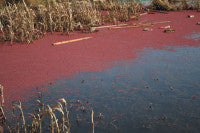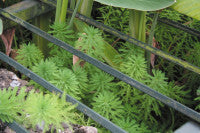Keeping the undesirables out can help safeguard your water resources
 Keeping the undesirables out can help safeguard your water resources
Keeping the undesirables out can help safeguard your water resources
Report by Languard's PAUL CAWOOD
Aquatic Weeds
Water forms a vital part of managing our green spaces. Whether it's the most prestigious golf course with beautifully proportioned showcase water features or a humble municipal pay and play that has a feature pond, water is crucial in providing the aesthetics we desire whilst ensuring the grass we play on is in top form.
Recent years have seen extremes in water availability from wet winters that have caused drainage to be pushed to the limit to dry summers that have parched fairways. In some cases last year municipal football and rugby pitches were closed as they had dried to the point where they were unsafe to use.
Water shapes the landscape and creates the spaces we enjoy as well as being the essential ingredient in ensuring the health of the grass. With the recent swings in rainfall it is a resource that is under growing pressure.
Last year saw increased restrictions on licences to abstract water for irrigation use. Some areas, notably in the south east, imposed bans on irrigation using mains water. As rainfall becomes less predictable managing water stocks and the equipment that stores it is crucial.
So what happens when you get unwelcome visitors in the form of aquatic weeds in your ornamental lake or irrigation pool? How do they get there? How can they be managed? There are some aliens out there that you should be aware of as they will dominate our aquatic environment with little or no resistance.
Aquatic weeds spread from some reliable sources. Plant fragments are the most likely form of spread from either mechanical sources (cutting and dredging) to spread by water foul. Many releases to the wild of non-native undesirable species are by the public simply dumping foreign ornamentals in the wild.
Most unwelcome aquatic weeds are non-native that have no place in our natural indigenous aquatic environment. Most of these invaders are escapees from domestic fish tanks that were used to oxygenate the water. They were sold by garden centres as both oxygenators for aquaria and features for garden ornamental ponds. As sometimes happens, when people tire of their aquarium, they free the fish in the local pond or river - and the plant life too.
As with all alien invaders of the plant kind they are released into an environment where they have none of the natural controls that exist in their indigenous environment. There are no diseases, invertebrates that feed on them, or fish that can graze them to keep them in check.
Without this natural restriction on their growth they literally spread unopposed in an environment that isn't equipped to cope with them. The consequences are often profound. Pools and ponds that have slow flowing water can be completely consumed by these fast growing invasive species. If your pool is the centrepiece of your course, or you have a storage lagoon for the summer's valuable irrigation water, then beware. These green invaders can get a foothold and become embedded very quickly and have a profound effect on both the appearance of your lake and the ability of your pumping equipment to work.
Solving the problem of aquatic weeds is specialist work that requires the expert touch. Here are just a few of the common problems that unwanted aquatic vegetation can bring.
Many courses use streams and balancing ponds to supply and replenish their irrigation water if it is not from a bore hole or the mains. This is an ideal system but careful maintenance is needed to ensure that aggressive fast growing weeds do not get in. The problems that occur if they do are clear:
• Water flows will be reduced
• Overflows can occur due to reduced flow rates
• The available volume for water storage will be reduced due to plant matter
• Pumping equipment will get fouled due to plant fragments
• Native plant species do not compete and die off
• The quality of the aquatic habitat is reduced
• Available oxygen levels are reduced affecting fish and invertebrate life
• Anaerobic conditions can be created resulting in 'foul' water
So who are the invaders and how are they stopped? They key culprits are Parrots Feather (Myriophylum aquaticum), Australian Swamp Stonecrop (Crasulla helmsii), water fern (Azolla filiculoides), reeds, rushes, sedges and algal blooms.
 The alien invaders.
The alien invaders.
Parrots Feather is grown and widely sold by aquatic garden centres for domestic use. It has spread since the 1960s to over three hundred wild sites in the UK. It favours slow flowing water with a high nutrient status. It grows quickly, reproduces asexually and spread from stem fragments. Its bulk reduces water flow which, in turn, can raise the silt levels of pools and ponds.
Cutting and clearing of this plant is not advised. It spreads through stem and root fragments which will then re-establish down stream. The best control is achieved through foliar applied herbicides, though this is specialist work that requires both an environmental risk assessment and consent from the Environment Agency. It is best to consult with an expert. Reducing nitrogen and phosphorous inputs will help manage the nutrient rich environment this plant needs. Remove its food source and it will be less able to compete. This is the ideal long term solution.
Australian Swamp Stonecrop is an immigrant from Tasmania that arrived in the 1920s. It was sold as an oxygenating plant for ornamental ponds and was released to the wild. It spreads rapidly from fragments from cutting. Swamp Stonecrop grows to form very dense mats of vegetation that can engulf smaller ponds and pools, often choking them completely. It severely reduces the oxygen content of water and out competes all other indigenous plants, impoverishing the aquatic environment. Cutting and removing is not advised as it causes it to spread downstream. The most effective treatment is to use either root applied or foliar herbicides.
use either root applied or foliar herbicides.
Water Fern is the only floating fern found in the UK. It is a native of North America. It floats on the water surface forming dense floating mats that shade out other plants and deoxygenate the water. It can cause serious problems to pumping and filtering equipment due to its size. In winter it turns a characteristic red colour. It is tiny and easily spread by contaminated water, or water birds. In times of stress it releases spores as a survival mechanism. There are many techniques to manage this floating pest. If possible, raising and then lowering water levels to leave it stranded on the bank is cheap and effective. If not, weed scoops will provide a short term solution, as will herbicides. Long term, increasing water flow, preventing it from gaining a foot hold, is the desirable option.
Native opportunists
In the right conditions native plants can establish and cause reductions in water flow and raise silt levels in pools, ponds and water storage lagoons. Sedges, reeds and rushes, when established, can quickly colonise new areas. They grow and spread via rhizomes that accumulate silt. This accumulation diverts water to other areas, often dropping the bankside water level making it shallow enough for other plants to colonise. This gradual process causes loss of capacity and the literal 'clogging up' of infrastructure that is designed to carry water or store it.
 This also causes a significant reduction in water flow increasing the risk of flooding in the event of heavy rainfall. If the capacity of the pool needs to be restored then the best option for remediation is dredging. This, however, is very costly as a form of weed control for which a foliar application of herbicide is the recommended method.
This also causes a significant reduction in water flow increasing the risk of flooding in the event of heavy rainfall. If the capacity of the pool needs to be restored then the best option for remediation is dredging. This, however, is very costly as a form of weed control for which a foliar application of herbicide is the recommended method.
Generally, mechanical control is highly destructive in terms of the habitat that is literally being removed. This gives the invertebrates no time to leave and re-establish elsewhere and, more likely than not, leaves them high and dry on the bankside exposed to passing predators. Foliar herbicides, applied by qualified, skilled operators are the most effective and least invasive solution.
Herbicides cause a slow die back of the vegetation allowing any fauna to migrate to other habitats within the pond. Well timed applications of Roundup Pro Biactive will achieve control only if the criteria and conditions for application can be met.
The red tide
Many water courses have suffered from seasonal algal blooms that are caused by a combination of conditions. The floating algae that cause blooms are a natural part of the water flora but, due to high nutrient availability in the pool, can reproduce rapidly generating the bloom. Algae that bloom often cause an unpleasant odour as well as making any water feature look unsightly.
The best management control is to manipulate the availability of the nutrients that enable the bloom. If they are frequent, a change to your fertiliser regime to lower the flow of nitrogen and phosphorous into the pool will limit the ability of the algae to bloom. If this is not an option, successful control can be achieved with ultrasonic equipment that disrupt the algal structure, causing the algae to die. Dyes that can be added to the water to prevent growth have shown some merit, though the change in colour may not be to the members' tastes. Herbicides are not advised as a solution as they provide a very short term period of control.
An innovative new product from Scotts - Pro Crystal will give swift control of algal blooms in enclosed lakes. It is a novel combination of micro organisms that process the nutrients that the algae thrive on, removing them from circulation. This modifies the nutrient status of the pond preventing the algae from blooming. Results are good and last for up to three weeks. The best longer term option, in addition to reducing nutrient availability, is Barley straw. This technique has been used successfully for many years as a low input low maintenance natural option. The straw is rolled into a sausage and then placed in the pond - simple and effective!
Managing weeds in a highly sensitive environment such as water is skilled specialist work. Acute awareness to the consequences of treatment and thinking ahead are essential to achieve, not only the result that is desired, but causing no harm. There are several cases of operatives treating weeds in streams unaware that lower down the stream the water was abstracted for agricultural irrigation.
As you can imagine crops do not usually respond well to irrigation with weak solutions of glyphosate! It is care and attention to detail that is needed when applying herbicides in this sensitive environment. It is the man behind the nozzle that makes the difference!
Paul Cawood, Languard Ltd
www.languard.co.uk
